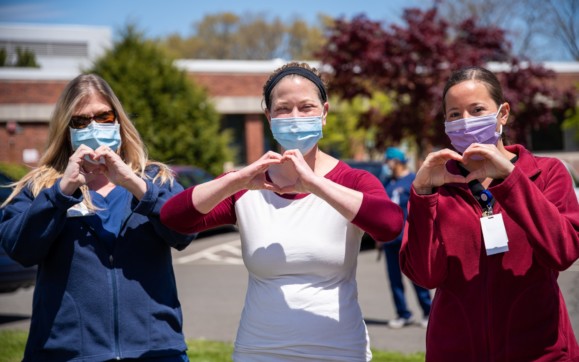6 Creative Data-Driven Ways to Fundraise During Nurses Week 2021

Nurses have stepped up in unprecedented ways to care for our communities. Your donors are ready to ensure nurses feel gratitude for their hard work and dedication. Nurses Week (May 6-12, 2021) is the perfect time to shine the spotlight on these caregivers and engage donors.
But, where do you begin?
Your Chief Nursing Officer (CNO) can help you better understand which ideas will resonate or be the most impactful. This relationship is critical for the foundation in many ways and your CNO can lend invaluable support, insight, and awareness across the organization.
Use the ideas below a starting point. And make sure to consider the data you have available to you before deciding the best way to engage donors in Nurses Week.
1. Fund Nursing Education
An appeal to fund nursing education is clear and straightforward. The nursing shortage has been widely publicized and most people are very aware of the critical role nurses play, especially during the pandemic. Whether you are funding an endowment or raising annual restricted dollars, donors can feel good about their donation directly supporting nurses. (Your CNO can help identify funding priorities if not already known to you.)
With this type of donation, it is critical to share impact in stewarding your donors. For example, your follow-up should include phrases like “your donation helped support ## nurses with advanced training” or “you helped to raise more than $XX for nursing scholarships.”
Who is the target donor?
If you are raising funds for a new named endowment, or bolstering a current endowment, you are looking for donors with a high capacity and likelihood to make a major or principal gift. A custom predictive model is your best bet for identifying this capacity and likelihood combination. If you are using affluence personas, you should target groups like philanthropists or affluent enigmas as well as those with high invested assets.
If you are raising annual restricted funds, you are looking for donors likely to make annual gifts and the humanitarian affluence persona. Humanitarians give more frequently and are engaged by messages of need.
2. Appeal to Former Clinicians
Retired physicians, nurses, and care staff understand the profession and the unique demands. They often want to leave a legacy of care – they want to make an impact and continue to support others who share their commitment of service. What a fabulous way of multiplying that personal mission by leaving a legacy gift to help future generations of nurses do the same. These are perfect people to approach with planned giving options.
Who is the target donor?
Use a custom, predictive model to identify supporters with planned giving likelihood, then cross-reference the top scores with a list of former clinicians. You may also be looking for the humanitarian affluence persona, who is more modest in means, but gives more frequently. Former clinicians who used payroll deduction for the employee giving campaign may be another great place to start. You may also want to review people who volunteered to help with the employee giving campaign –individuals who have shown a desire to give back to their colleagues through a more involved commitment. In terms of wealth, you’re looking for modest invested assets, however they might also have a higher level of real estate or multiple real estate holdings.
3. Target First-time In-kind Supporters (Think COVID Donors!)
Most healthcare organizations experienced an influx of new donors during the pandemic. These “COVID donors” have already shown a likelihood to support your organization and its clinical staff. According to data from Blackbaud Raiser’s Edge NXT®, in-kind donations to healthcare organizations increased by 61% in 2020. Now is the time to transition these donors from in-kind giving to cash/out-right giving. You have the opportunity to be proactive rather than reactive and communicating how their philanthropy can have maximum impact (which likely isn’t in-kind giving).
It is also an opportunity to show the one-time pizza, doughnuts, etc. donors the impact they could make with a cash donation each month. Encourage these donors to show up as a monthly recurring donor (or sustainer) just like nurses show up each day to care for their friends and neighbors.
Who is the target donor?
All in-kind donors. But, if you want to get more specific, layer your list of in-kind donors with wealth data and affluence personas to determine the best types of asks and messaging. There are also analytics available that identify those donors most likely to become a sustainer donor.
4. Fund Identified Needs of Nursing Staff Beyond Education
Work with your Chief Nursing Officer to determine current staff needs and quickly package the ask in a crowdfunding campaign. Make sure the campaign is raising funds that fit an organizational need and calculate a needed yet reasonable dollar goal. You don’t want donors asking friends for donations to fund things the hospital can’t or won’t use. Lean into the ‘What can I do to help?’ sentiment.
Who is the target donor?
Some supporters are more likely to fundraise on your behalf. Using predictive scoring, you can reach out to those most likely to become a peer-to-peer fundraiser. Plus peer-to-peer personas segment constituents based on attributes such as causes they prefer to support, motivations, life stage, demographics, and potential dollars raised. These two tactics combined give you a list of supporters most likely to respond to this type of ask.
5. Identify a Challenge Gift (Without Asking Your Board of Directors Yet Again)
If you already have a campaign planned for Nurses Week, this could be a great bonus. Challenge gifts help to generate more excitement from supporters and can bring in a competitive element. My challenge to you is to look beyond your board of directors for the gift. Leverage the impact and share the excitement towards the end of a week-long effort.
Who is the target donor?
When looking for a challenge donor, you are looking for an individual with high net worth or high invested assets. They might also have a lot of high dollar confirmed gifts to other organizations via NOZA. Consider the affluent enigma persona, individuals with high capacity and no publicly-celebrated giving history with giving history to you. If they give quietly, what a great match for the challenge gift from ‘an anonymous donor.’
6. Say Thank You
Before you request a donation, ask potential supporters to show their appreciation with a virtual thank you wall or e-card (similar to Bo Crader’s recommendation for Doctors’ Day). This type of support helps to build a culture of philanthropy both within the hospital’s walls and within the community. A culture of philanthropy is one of the first steps to increasing philanthropic revenue.
Once the supporter has signed the virtual wall or sent the virtual thank you card, make sure you include a soft ask on the confirmation page or response email. You might be surprised to see how many people choose to give after expressing their gratitude for care.
Who is the target donor?
The doors are wide open for this group! To start, focus on e-mail communication for the easiest implementation and readability factor for your team. Utilize your custom, predictive models and donor personas in your follow up from the results that you’ve tracked in your CRM. Did a philanthropist with a high level of invested assets send a heart-felt virtual note? Follow up with a notecard or personal phone call. Layer your stewardship, starting with an email for all of your respondents, and advance to a priority prospect group for personal phone calls. Even if the activity yields modest revenue, you’ve created a dialogue with good stewardship and prospecting opportunities.
Once you’ve implemented these ideas in your healthcare organization, it is time to focus on retention! Share results from your Nurses Week appeals as a stewardship tool. These donors clearly care about nursing-related philanthropic avenues and elevating the nursing community. They will be excited to hear their impact and your foundation’s focus on nurses.
I would love to hear about your organization’s Nurses Week efforts in the comments!
